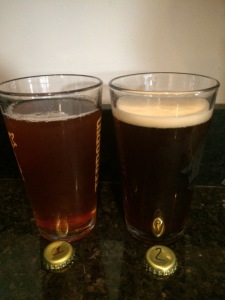This post is one in a series of making small adjustments to a single recipe in order to improve it, learn more about the impact each ingredient has on the finished product, and the art of recipe creation. The rest of the comparison tastings in this series can be found here.
Memory is flawed. It’s science. We simply don’t have as accurate of a memory as we’d like to believe. Without going too Eternal Sunshine of the Spotless Mind, we misremember things all the time due to our perceptions, idealizations, and, quite frankly, desires for something other than what actually occurred to be true. Because of all this, it seems difficult to me to fairly judge the improvements between batches unless I can taste them back to back. It’s easy for me to enjoy one beer more than another just because it’s the beer that’s in front of me at that moment—but that non-critical enjoyment won’t help me improve this recipe.
Before I get too far, I would like to acknowledge an important shortcoming of this approach. I fully understand that age is a vital factor in how a beer tastes. I admit that I’m making a hoppy beer, and that it will be impossible for me to get a 100% fair comparison of those flavors and aromas. I recognize that I don’t have enough refrigerator space to store all of my beers at an ideal temperature, so I may have to abandon my hope of comparing early iterations to my later ones. However, I will attempt to take these elements into consideration while comparing different versions by (at best) noting the reason for the difference in hop character or (at worst) trying to conjure up the original flavors of early iterations by using the ghost of that beer as a springboard for my memory.
Now that that’s out of the way, I should point out that if I learned one thing by doing a side by side tasting, it’s that having two pint glasses in front of you makes you look like a lush in front of your wife. But I took notes, so it’s a learning experience, right?
Recap
You can see the full recipes of Iteration 1 and Iteration 2 in the links, but I want to note here that the only difference in these two beers was that Number 1 had a pound of crystal 80 and Number 2 had a pound of crystal 120. Another (unintentional) difference was the higher gravity and subsequent higher ABV in Iteration 2, which was due to a change in lautering technique.

Appearance
It’s hard to tell the exact difference in color from the picture above because of my black countertop, but the difference between them is not as drastic as it appears. Iteration 1 is certainly more of a copper/amber color, but Iteration 2 is also dark amber and not quite red. For the record, these beers only have an estimated difference of 2 SRM.
Beer 1 had no head whatsoever, so there is no head retention to speak of. This was not my experience before, though, and makes me wonder if the cap on this bottle wasn’t as tight as it should have been. Beer 2 poured with a medium head and had fair retention.
Aroma
The aroma of Iteration 1 was understandably less present than when I first brewed it. However, it did still have citrus notes in the nose as well as some faint malt sweetness. Iteration 2 had a stronger citrus aroma (and as I didn’t change my hop schedule, I’m chalking this up to age alone), but it also had a moderate smell of dark fruit. Particularly, I noted the scent of plum and dark cherry.
Flavor
Iteration 1 had notes of caramel and toffee up front and finished bitter with a hint of citrus and a more substantial floral flavor. The bitterness was lingering, but not unpleasant. All in all, I was quite happy with the level of bitterness in this beer.
With Iteration 2, I tasted flavors of cherry and plum immediately with a citrus background. This beer had a moderate maltiness with a background bitterness, bitter middle, and bitter finish. The bitterness of this beer, though, did not linger as it did with Number 1. This change in malt character and the difference in its quality show me that I’m on the right track to getting this recipe where I want it to be.
Final Thoughts
One thing that surprised me was that Iteration 1 came across as sweeter than Iteration 2 due to the caramel flavor. This was interesting to me since Iteration 2 was five points higher in OG and had an FG that finished two points higher. Also, since the amount of hops, AA% of those hops, and the boil schedule remained the same in both beers, Iteration 2 had a lower BU:GU ratio, which caused me to expect a balance swing towards a maltier flavor overall. This leads me to believe that not only is the BU:GU ratio important, but the quality of that ratio is just as important. What I mean by “quality” is the specific flavors in the malts themselves. The lighter C80 has more candy-like toffee/caramel flavors, while the C120 comes across as fruit sweetness, causing the beer with C80 to taste sweeter even though the beer with C120 had a higher OG and FG. This takeaway gives me hope regarding the decisions I made for Iteration 3 (currently bottle conditioning), and I’m looking forward to seeing if I’ll be vindicated in those choices.
